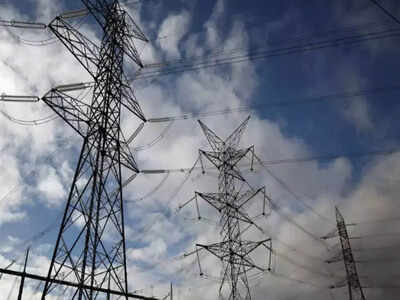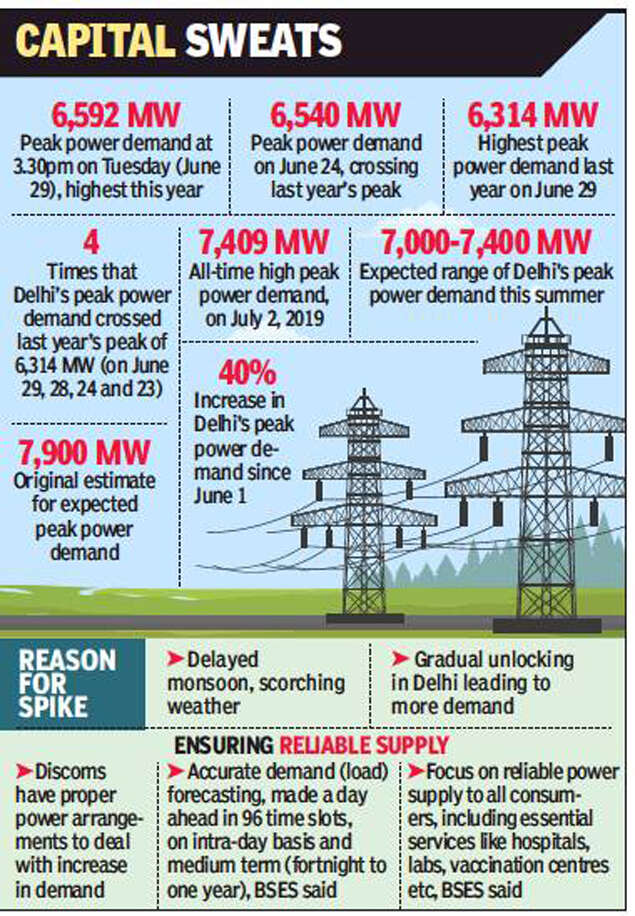Top Searches
- News
- City News
- delhi News
- Peak power demand at 6,592 MW as Delhi unlocks, gets no rain breather
Peak power demand at 6,592 MW as Delhi unlocks, gets no rain breather

Representative image
NEW DELHI: A delayed monsoon, the scorching heat and a city getting unlocked each passing week has resulted in Delhi’s power demand surging.

The capital’s peak power demand was clocked at 6,592 MW on Tuesday — the highest for the season till now.
Apart from the hot and humid weather, the gradual unlocking process has resulted in Delhi’s peak power demand being clocked at 6,592 MW at 3.30pm on Tuesday, which is not only this season’s highest till now but also crossed the season’s previous peak of 6,540 MW, recorded on June 24. On June 10, Delhi’s peak power demand was recorded at 6,499 MW, eclipsing last year’s peak of 6,314 MW.
With more offices and businesses reopening, coupled with the sultry weather and a missing monsoon, officials expect Delhi’s peak power demand to reach the range of 7,000 MW to 7,400 MW, even though the original estimates for this summer was around 7,900 MW.
Because of the coronavirus-induced lockdown at this time last year, the city’s peak power demand was recorded much lower than the all-time high peak power demand of 7,409 MW on July 2, 2019.
On June 7, Delhi’s peak power demand crossed 5,000 MW for the first time this season, clocking 5,559 MW at 11.19pm and from June 1, 2021, Delhi’s peak power demand has increased by over 40%, officials said.
In fact this year, Delhi’s peak power demand has already crossed last year’s peak of 6,314 MW on four occasions — June 29, 28, 24 and 23. In the month of June 2020, Delhi’s peak power demand crossed the 6,000 MW-mark only by June 18 and a peak power demand of 6,314 MW was recorded on June 29.
“Ensuring reliable supply in any season is as much the function of proper power arrangements as also of accurate demand forecasting and robust distribution network. BSES discoms are fully geared-up on all these aspects to meet the power demand,” said a BSES spokesperson.
“We are closely watching the evolving coronavirus situation in the national capital and taking all appropriate measures to ensure reliable power supply to all consumers including essential services such as hospitals, labs, quarantine centres, vaccination centres etc., without compromising the safety of our employees,” the spokesperson said, adding that the company was in constant touch with all relevant stakeholders on the evolving situation in the capital.
He said that accurate demand forecasting is critical for reliable power supply and it is done on various parameters that range from the day-ahead in 96 time-slots, intra-day basis and medium-term from a fortnight to one year.
“Among other aspects, weather parameters like temperature, rainfall, cloud coverage, wind speed, wind direction and humidity play an important role in accurate demand forecast. Even holidays and random disturbances have an impact on the power demand,” the BSES official added.
“To meet today’s power challenges and to get a grip on so many varied and dynamic variables, BSES uses a mix of advanced statistical forecasting models, combined with state-of-the-art weather forecasting solutions, including artificial intelligence (AI) and machine learning,” he added.

The capital’s peak power demand was clocked at 6,592 MW on Tuesday — the highest for the season till now.
Apart from the hot and humid weather, the gradual unlocking process has resulted in Delhi’s peak power demand being clocked at 6,592 MW at 3.30pm on Tuesday, which is not only this season’s highest till now but also crossed the season’s previous peak of 6,540 MW, recorded on June 24. On June 10, Delhi’s peak power demand was recorded at 6,499 MW, eclipsing last year’s peak of 6,314 MW.
With more offices and businesses reopening, coupled with the sultry weather and a missing monsoon, officials expect Delhi’s peak power demand to reach the range of 7,000 MW to 7,400 MW, even though the original estimates for this summer was around 7,900 MW.
Because of the coronavirus-induced lockdown at this time last year, the city’s peak power demand was recorded much lower than the all-time high peak power demand of 7,409 MW on July 2, 2019.
On June 7, Delhi’s peak power demand crossed 5,000 MW for the first time this season, clocking 5,559 MW at 11.19pm and from June 1, 2021, Delhi’s peak power demand has increased by over 40%, officials said.
In fact this year, Delhi’s peak power demand has already crossed last year’s peak of 6,314 MW on four occasions — June 29, 28, 24 and 23. In the month of June 2020, Delhi’s peak power demand crossed the 6,000 MW-mark only by June 18 and a peak power demand of 6,314 MW was recorded on June 29.
“Ensuring reliable supply in any season is as much the function of proper power arrangements as also of accurate demand forecasting and robust distribution network. BSES discoms are fully geared-up on all these aspects to meet the power demand,” said a BSES spokesperson.
“We are closely watching the evolving coronavirus situation in the national capital and taking all appropriate measures to ensure reliable power supply to all consumers including essential services such as hospitals, labs, quarantine centres, vaccination centres etc., without compromising the safety of our employees,” the spokesperson said, adding that the company was in constant touch with all relevant stakeholders on the evolving situation in the capital.
He said that accurate demand forecasting is critical for reliable power supply and it is done on various parameters that range from the day-ahead in 96 time-slots, intra-day basis and medium-term from a fortnight to one year.
“Among other aspects, weather parameters like temperature, rainfall, cloud coverage, wind speed, wind direction and humidity play an important role in accurate demand forecast. Even holidays and random disturbances have an impact on the power demand,” the BSES official added.
“To meet today’s power challenges and to get a grip on so many varied and dynamic variables, BSES uses a mix of advanced statistical forecasting models, combined with state-of-the-art weather forecasting solutions, including artificial intelligence (AI) and machine learning,” he added.
FacebookTwitterLinkedinEMail
Start a Conversation
end of article
